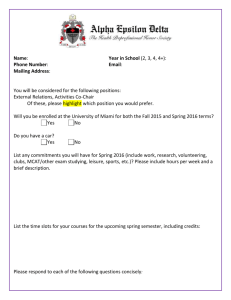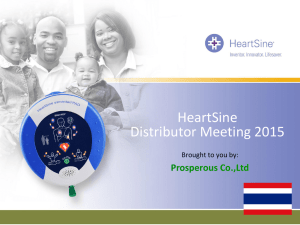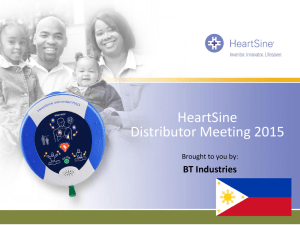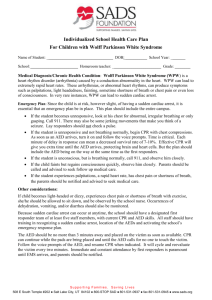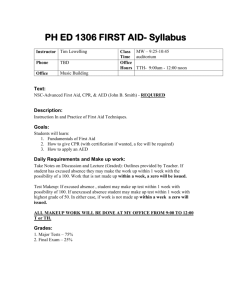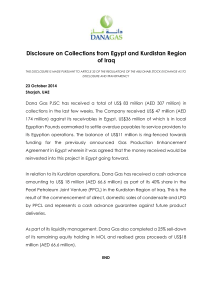MED - 500.01 AED Program - South Lynches Fire Department
advertisement
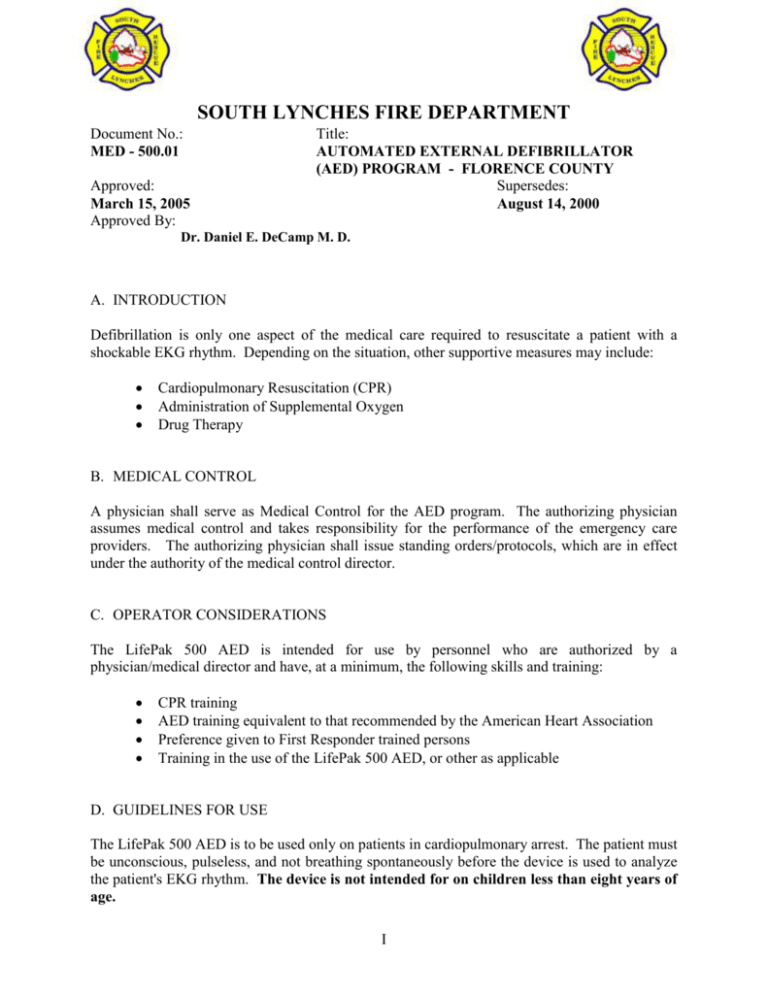
SOUTH LYNCHES FIRE DEPARTMENT Document No.: MED - 500.01 Approved: March 15, 2005 Approved By: Title: AUTOMATED EXTERNAL DEFIBRILLATOR (AED) PROGRAM - FLORENCE COUNTY Supersedes: August 14, 2000 Dr. Daniel E. DeCamp M. D. A. INTRODUCTION Defibrillation is only one aspect of the medical care required to resuscitate a patient with a shockable EKG rhythm. Depending on the situation, other supportive measures may include: Cardiopulmonary Resuscitation (CPR) Administration of Supplemental Oxygen Drug Therapy B. MEDICAL CONTROL A physician shall serve as Medical Control for the AED program. The authorizing physician assumes medical control and takes responsibility for the performance of the emergency care providers. The authorizing physician shall issue standing orders/protocols, which are in effect under the authority of the medical control director. C. OPERATOR CONSIDERATIONS The LifePak 500 AED is intended for use by personnel who are authorized by a physician/medical director and have, at a minimum, the following skills and training: CPR training AED training equivalent to that recommended by the American Heart Association Preference given to First Responder trained persons Training in the use of the LifePak 500 AED, or other as applicable D. GUIDELINES FOR USE The LifePak 500 AED is to be used only on patients in cardiopulmonary arrest. The patient must be unconscious, pulseless, and not breathing spontaneously before the device is used to analyze the patient's EKG rhythm. The device is not intended for on children less than eight years of age. I E. QUIK-COMBO ELECTRODES The AED uses disposable Quik-Combo defibrillation/EKG electrodes with or without the REDIPAK preconnect system. The use of Quik-Combo electrodes allows rapid transfer of care to other devices that also use Quik-Combo electrodes, such as Physio Control's LifePak 10 monitor/defibrillator. F. SHOCK WARNING The rescuer must always state loudly a "clear the patient" message such as: "I'm clear. You're clear. Everybody clear", or simply "Clear", before pressing the shock control. G. COORDINATION BETWEEN ACLS PERSONNEL AND AED USERS The following guidelines are suggested for the interface between ACLS personnel and personnel using AEDs. ACLS-trained and authorized providers should have authority over the patient transferred to them after initial contact has been established with the AED users. On arrival, ACLS-trained providers should ask for a quick report from the AED user, and then direct them to proceed with their protocol. This is particularly applicable when ACLS-trained providers are unfamiliar with the operation of the AED. ACLS-trained providers should consider the shocks delivered by the AED user as part of their ACLS protocols. For example, if the patient remains in ventricular fibrillation after three (3) shocks by the AED, then the ACLS provider should enter the ACLS ventricular fibrillation treatment sequence at the point at which the first three shocks have been delivered. The AED should be removed and a conventional monitor/defibrillator attached only when clinically convenient, provided that the AED is operable and performing as is should. H. POSTRESUSCITATION CARE Once an AED user team completes its protocol, several things could happen. No matter what the outcome, patient care remains paramount. If the patient regains a pulse, the AED/resuscitation team will continue to provide supportive care with one or a combination of the following: Proper airway control and ventilatory management Supplemental oxygen, if available Appropriate airway clearance if vomiting occurs Continued monitoring of vital signs Physical stabilization and transport Continued support while awaiting the arrival of ACLS provider team II I. TRANSFER OF PATIENT TO EMS/ACLS WITH OTHER DEVICE The Quik-Combo electrodes allow rapid transfer of care to the devices that also use Quik-Combo electrodes. To transfer the patient from the LifePak 500 AED to another device: Turn off the power to the LifePak 500 AED. Disconnect the Quik-Combo electrodes from the LifePak 500 AED. Leave the electrodes on the patient. Connect the Quik-Combo electrodes to the Quik-Combo therapy on the next device. J. CASE REVIEW and QUALITY ASSURANCE Every event in which an AED is used must be reviewed by the medical director or designated representative. This means that every incident in which CPR is performed must have a medical review to establish whether the patient was treated in accordance with professional standards and local standing orders/protocols. The case-by-case reviews will be performed in two ways; by written/printed report and by the memory of the AED which stores information about the usage event. Case reviews utilizing both of these types provide more complete information. Quality Assurance refers to both the microperformance, that is, the performance of personnel involved in the treatment of individual patients; and the macroperformance, that is, the overall effectiveness of a system using AEDs. Review of the treatment of an individual patient in cardiac arrest can lead to identification of a problem in a system's training program. K. TRAINING PROGRAM The only pyschomotor skills required by an AED user involve recognition of a cardiac arrest, proper attachment of the device, and adherence to the memorized treatment sequence. Learning to use and operate an AED is easier than learning to perform CPR. Initial training for AED operators will consist of the following: Completion of D.O.T. First Responder or equivalent course, including certification in Cardiopulmonary Resuscitation (CPR) through the American Heart Association. Completion of a training program on the Physio Control LifePak 500 using a combination of manufacturer's recommended training programs and/or materials, as well as the American Heart Association's AED training information. Training will designed to ensure the most efficient care of the patient using the ECC/Chain of Survival concepts. Trainees shall know how to interact between CPR and AED usage. III I. USAGE OF A AED DEVICE 1. Indications Patients who are pulseless, apneic, and 12 years of age or older and/or weigh more than 90 pounds 2. Contraindications The presence of breathing, pulse, or responsiveness. 3. Precautions a. Ensure that the patient is pulseless before initiating AED usage. b. Avoid direct contact with the patient while the defibrillator is analyzing or defibrillating the patient. c. Avoid contact with metal or other conductive materials. d. Announce "Clear" and visualize that everyone is clear prior to defibrillating the patient. 4. AED usage protocol a. Establish unresponsive. b. Check ABCs (Airway, Breathing, Circulation) c. Begin CPR if indicated, until AED is ready for operation. d. Ensure that the chest is dry, remove medication patches and jewelry, and shave excessive hair if necessary. e. Stop CPR and verify pulselessness. f. Operate AED 1. Press "ON" to turn the AED on, green light will come on. 2. The "CONNECT ELECTRODES" message and voice prompt will occur until the patient is connected. 3. Prepare for electrode placement. Place the patient on a hard surface away from water or conductive material. Remove clothing from the patient's upper torso. Verify Step d above. If shaving is required, be careful not cut skin. 4. Apply the electrodes to the patient's chest. Place the electrode with the heart design lateral to the patient's left nipple with the center of the electrode in the mid-axillary line, if possible. Place the other electrode on the patient's upper right torso, lateral to the sternum and below the clavicle. Starting from one end, press the electrodes firmly onto the patient's skin. 5. Connect the electrode cable connector to the AED. 6. Follow the screen messages and voice prompts provided by the AED. 5. Shock Procedure (If Shock Advised) a. Announce "Clear", visualize the area, and press "SHOCK". b. Analyze. c. If shock advised, announce "Clear" and press "SHOCK". d. Analyze. e. If shock advised, announce "Clear" and press "SHOCK". f. Check. Pulse. If no pulse is present, perform CPR for one (1) minute. g. Check pulse. IV h. If no pulse present, analyze. i. If shock is advised , repeat steps 5.a -5h above. j. AED users should continue to repeat the above until any of the following occurs: AED advises "NO SHOCK". Pulse is restored. Patient care is properly handed off to EMS personnel. 6. If "NO SHOCK" is advised at any time: a. Perform CPR for one minute if patient remains pulseless. b. Analyze If shock is advised continue CPR, follow protocol, and advise EMS of status. J. SPECIAL SITUATION 1. When placing electrodes on the patient, be aware of the following special situations; Obese patients or patients with large breasts - Apply the electrodes to flat area on the chest, if possible. If skin folds or breast tissue prevent good adhesion, spread skin folds apart to create a flat surface. Thin patients - Follow the contour of the ribs and spaces when pressing electrodes onto the torso. This limits air space or gaps under the electrodes and promotes good skin contact. Patients with Implanted Pacemakers - If possible, place Quik-Combo electrodes away from the internal pacemaker generator. Treat this patient like any other patient requiring care. Pacemaker pulses may prevent advisement of an appropriate shock, regardless of the patient's underlying rhythm. Patients with Implanted Defibrillators - Apply the electrodes in the anteriorlateral position. Treat this patient like any other patient requiring care. History: August 14, 2000 - Update with new Medical Control Administrator approval. V VI

